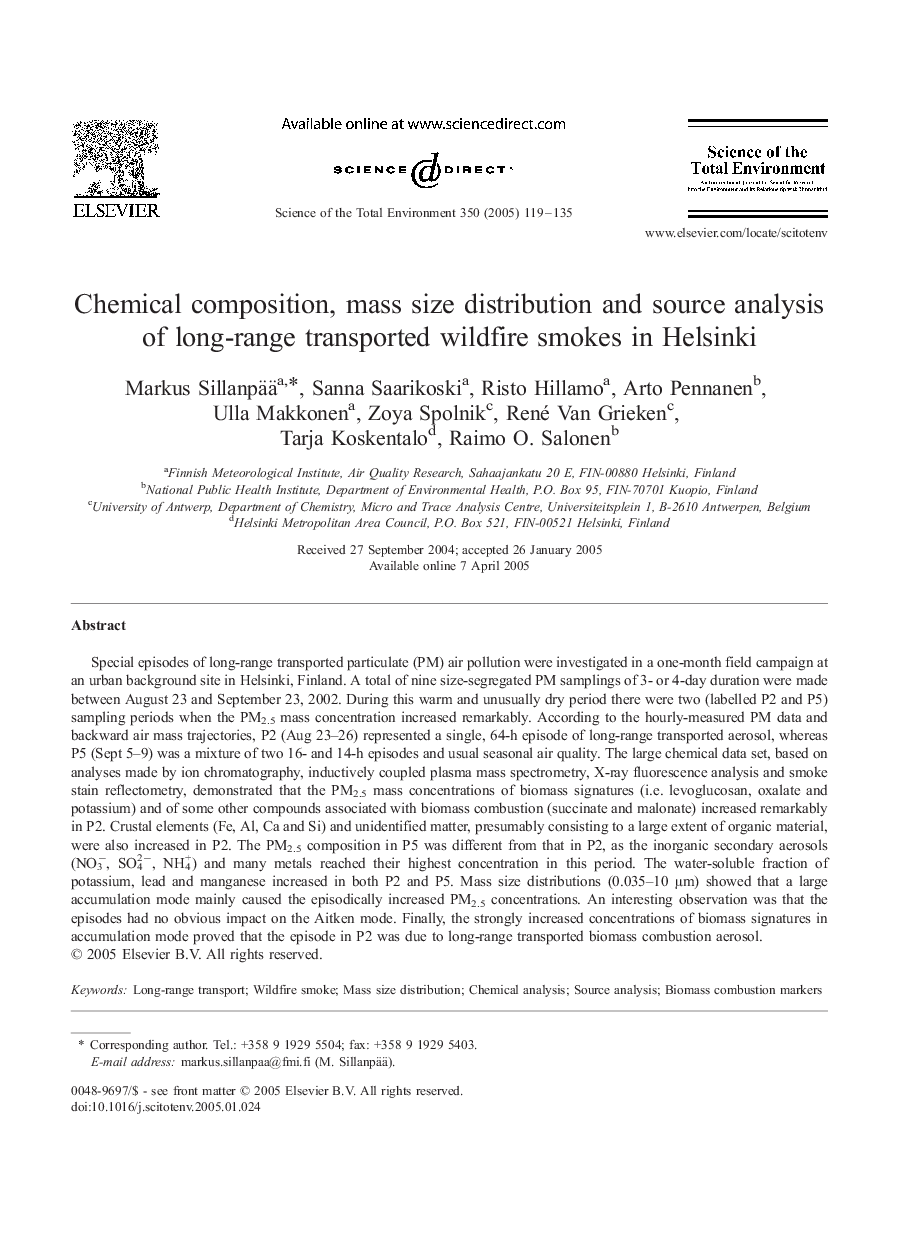| کد مقاله | کد نشریه | سال انتشار | مقاله انگلیسی | نسخه تمام متن |
|---|---|---|---|---|
| 10110597 | 1619988 | 2005 | 17 صفحه PDF | دانلود رایگان |
عنوان انگلیسی مقاله ISI
Chemical composition, mass size distribution and source analysis of long-range transported wildfire smokes in Helsinki
دانلود مقاله + سفارش ترجمه
دانلود مقاله ISI انگلیسی
رایگان برای ایرانیان
کلمات کلیدی
موضوعات مرتبط
علوم زیستی و بیوفناوری
علوم محیط زیست
شیمی زیست محیطی
پیش نمایش صفحه اول مقاله

چکیده انگلیسی
Special episodes of long-range transported particulate (PM) air pollution were investigated in a one-month field campaign at an urban background site in Helsinki, Finland. A total of nine size-segregated PM samplings of 3- or 4-day duration were made between August 23 and September 23, 2002. During this warm and unusually dry period there were two (labelled P2 and P5) sampling periods when the PM2.5 mass concentration increased remarkably. According to the hourly-measured PM data and backward air mass trajectories, P2 (Aug 23-26) represented a single, 64-h episode of long-range transported aerosol, whereas P5 (Sept 5-9) was a mixture of two 16- and 14-h episodes and usual seasonal air quality. The large chemical data set, based on analyses made by ion chromatography, inductively coupled plasma mass spectrometry, X-ray fluorescence analysis and smoke stain reflectometry, demonstrated that the PM2.5 mass concentrations of biomass signatures (i.e. levoglucosan, oxalate and potassium) and of some other compounds associated with biomass combustion (succinate and malonate) increased remarkably in P2. Crustal elements (Fe, Al, Ca and Si) and unidentified matter, presumably consisting to a large extent of organic material, were also increased in P2. The PM2.5 composition in P5 was different from that in P2, as the inorganic secondary aerosols (NO3â, SO42â, NH4+) and many metals reached their highest concentration in this period. The water-soluble fraction of potassium, lead and manganese increased in both P2 and P5. Mass size distributions (0.035-10 μm) showed that a large accumulation mode mainly caused the episodically increased PM2.5 concentrations. An interesting observation was that the episodes had no obvious impact on the Aitken mode. Finally, the strongly increased concentrations of biomass signatures in accumulation mode proved that the episode in P2 was due to long-range transported biomass combustion aerosol.
ناشر
Database: Elsevier - ScienceDirect (ساینس دایرکت)
Journal: Science of The Total Environment - Volume 350, Issues 1â3, 1 November 2005, Pages 119-135
Journal: Science of The Total Environment - Volume 350, Issues 1â3, 1 November 2005, Pages 119-135
نویسندگان
Markus Sillanpää, Sanna Saarikoski, Risto Hillamo, Arto Pennanen, Ulla Makkonen, Zoya Spolnik, René Van Grieken, Tarja Koskentalo, Raimo O. Salonen,